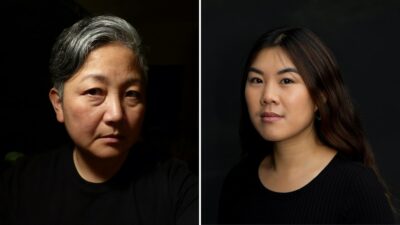“I once heard that moths represent ancestors who visit to bring messages.” I examine the frond of a licorice fern, emerging from a moss-covered branch. “Is that a thing in Japan, too?”
“I think it’s a belief in many cultures…” Hiromi’s voice drops to a whisper, “Look! A frog.” Click click. Her lens points out a brown speckled frog, whose head peeks out from a pool of water. When Hiromi emerges from behind the camera, she is beaming. She has never seen a northern red-legged frog this large before and it is considered a species at risk.
Dozens of moths flit through the airy forest as Hiromi and I descend into Lynn Valley, Ch’ich eliwxih, as the watershed is referred to in Skwxwú7mesh language. Dark lacy patterns decorate the insects’ pale brown wings. They surround us all day: resting atop boulders, perching on craggy trunks of Douglas Firs, and dancing along the river.
I cannot help but feel like my body takes up too much space here, though I don’t stand any taller than 5’1″. However, this is what I worry about as moth wings flutter with commotion when we brush vegetation or when they collide mid-air with my human-sized frame. I understand that the idea of Nature as a pristine and untouched environment is a colonial fantasy. Indigenous people have lived on and with this land since time immemorial. In this area, Skwxwú7mesh families gathered food and feasted, even despite the potlatch ban enacted by the Canadian Government until the 1950’s. However, even while knowing all this, it remains difficult to not feel like an oaf when a small woodland creature falls to the ground from the impact of hitting your chest.
“Which of my ancestors was that?” I whisper under my breath, tilting my head towards the ground.
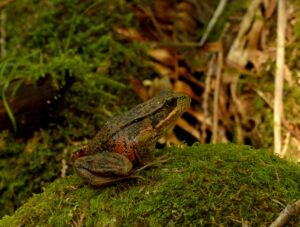
Northern red-legged frog. Photo by Hiromi Goto
~
Author Hiromi Goto has been my writing mentor for nearly a year. We work and learn alongside one another creatively as writers and also share overlapping ancestry as an emigrant from Japan (Hiromi) and a yonsei Japanese and Chinese descendent (myself). During the summer of 2020, the two of us recorded a conversation at Queer Arts Festival (QAF) on the topic of intergenerational mentorship as queer writers of colour.[i]
During our conversation, I learned that Fred Wah, Aritha Van Herk, and SKY Lee are a few of the authors who Hiromi considers as mentors in the development of her career: “SKY Lee was queer and a mom and that made it seem possible for me to think, ‘Okay, I can do this, too.’ SKY published amazing trailblazing work and had a big impact in Canadian literature.”
When Hiromi was growing up, she formed a unique friendship with an English teacher, who allowed her to hang out at her house outside of school hours.
“There was something very special for me to be seen, respected as a young person, and treated as an equal by someone who was older and not a family member. Somehow, it made me feel like it was possible to imagine being out in the world, being sustained, and having new relationships and friendships. It was peculiar to have that kind of friendship, trust, and respect between someone who is considerably older than me… there’s something about an older stabilizing force, outside of family, that was really meaningful.”
This makes sense to me, especially since I jokingly refer to Hiromi as my soft butch auntie. I tell her, “You see me as a whole person, not just as an artist. You and I connect over ideas and shared values beyond the art, but that are still rooted in our writing life. Having radical older people in my life has been affirming and encouraging to keep going. Oftentimes, it feels like my friends who are queer artists and millennials are flailing, like 70 percent of the time, if not more.”
“Flailing. You get better at it.” Hiromi reassures me, “It’s repeated for years.”
“You stop posting about it on your Instagram stories.”
“No drunk tweeting.”
We both laugh.
~
In an auntie-like fashion, Hiromi has prepared onigiri and mugi-cha for our forest adventure today. I have packed slices of leftover pizza. The warm fall sun shines on us as we sit by the rushing water to eat: Hiromi, on the riverbank, and I, on a large rock poking out of the river itself. Hiromi carefully slips off her shoes and slowly dips her feet in the water, inch by inch. I watch her flinch as she takes another step. “How is it?” I call out. My own boots have already been tossed to the side.
This forested area made international news last year after a local archaeologist found “14 small houses … a garden, a wood-lined water reservoir, and what may have been a shrine,”[ii] built by Japanese settlers that dated back to as late as the 1920’s. A video shows archaeology students sifting through soil at the roots of second-growth coniferous trees.[iii] A wooden table is lined with Japanese ceramic bowls and bottles made of green glass, unearthed among more than a thousand items including teapots, sake flasks, combs, toothbrushes, pocket watches, knives, and fragments of a camera. Large rocks sit wedged into the soil, carefully stacked in a narrow semi-circle, and the archaeologist describes the remnants of the ofuro, a Japanese bathhouse.
Whether by choice, racist employment restrictions, or way of forced assimilation and indentured labour, our ancestors have played a role in shaping this landscape. Our ancestors fished these coastal waters, felled these trees, farmed these lands, and built highways and roads. Our ancestors created this community in the forest, too. Far from their homelands, they found ways to care for one another.
~
As much as I learn from Hiromi, she learns from me too.
“One of the things I really appreciate about our relationship is the intergenerational aspect of it,” she says. “I think people become quite tied to the generation they grew up in terms of how we understand things. Something I vowed as a young person was that I wanted to be able to keep on learning and integrating new ideas and not get set in my ways. It’s quite hard to be continually open to new ideas. Being able to talk to someone who is younger and experiencing really substantive shifts—like the idea of being non-binary—these were not things that came to me so readily.”
Hiromi asks me what I have been surprised to learn from her through this process.
“Being able to witness an older person’s life so closely has been a great reminder of pacing,” I reply. “Because I see how you balance your career and your writing with other parts of life. You don’t take on more than what you are able to. You’re a freelance writer, so you are writing and editing all the time, but you also find time to pursue your interests, like photography, and cultivate relationships, whether with your partner, your adult children, community, or nature.”
As hardworking as Hiromi is, she also teaches me the importance of play.
~
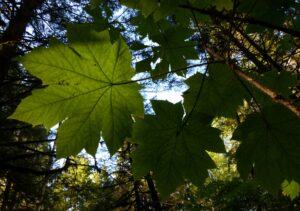
Devil’s club leaves. Photo by Hiromi Goto.
I scramble across a dry creek bed beneath the shade of evergreens.
“Look! Devil’s club.”
I point to where the dry creek bed has led us, calling back to Hiromi who clambers beneath the log I chose to climb over. We gaze up at the plant with admiration. From the ground, small pockets of light peek through gaps between hand-shaped leaves, wider than my face. Sharp spikes surround its crooked stem, like an armour of sorts.
Before Chinese migrants constructed the Canadian Pacific Railway, this plant tormented white settler land surveyors, forcing them to re-route plans for railway expansion across BC. One surveyor described suffering all night long while picking brittle thorns out of his knees “after slashing…through a mile or two of these a day.”[iv] Meanwhile, Devil’s club is considered a powerful healing plant by dozens of Indigenous nations on the west coast.[v] It contains spiritual and medicinal purposes for cleansing, purification, and protection. It is “a living being with a spirit and the capacity to help or harm humans, depending upon how it is approached.”[vi]
“If I’m four foot ten…” Hiromi calculates under her breath, “it must be at least ten feet tall!” She discards the pack on her back and approaches with her camera in hand and fabric mask dangling from her neck. Hiromi crawls beneath the plant, carefully scooting backwards on the ground. “There are moths under the leaves!” she calls to me from beneath its broad green understory, captured with the click of a shutter.
~
“There was very likely a small community of Japanese who were living here on the margins of an urban area.” The archaeologist described to reporters, “I think they were living here kind of in secret. […] The people who didn’t want to assimilate would have found refuge here.”[vii]
~
I reflect upon the care and sense of safety one may acquire through community: “Queer relationships can save lives, not just romantic ones, but platonic friendships, too. Especially because for so many queer people, our families may not know how to affirm or see us.”
The feeling of living on the margins is often familiar for queer and trans people of colour. Peer mentorship can be essential to survival.
Hiromi adds, “My [queer friends] were so supportive when I was coming out. I had a lot of questions. I grew up in a small town. My parents were Christian and there wasn’t a lot of queer culture that I could see around me socially or culturally, and we didn’t have the Internet. I really didn’t have any kind of larger cultural consciousness about queer life, so I’d ask my friends. They were very generous, and I don’t know what I would have done without them.”
~
“The slugs! They’re having sex!” Hiromi points at a sticky glob on the forest floor. Two slugs, entangled, a slimy pod between two curved lumpy bodies. I later learn that many slugs are hermaphrodites and determine their preferred gender roles during sex. Others are asexual and can self-fertilise.
“Is it inappropriate to take a picture? It’s literal nature porn!”
Hiromi starts laughing.
~
At my age, Hiromi was learning how to parent: “During a year of taking my first writing course at the University of Calgary with Fred Wah, I married a man and became pregnant with my first child. My professional and writing career was braided into becoming and learning to be a responsible parent, and also coming out—my queer life, writing life and parenting life, all converged!”
My artistic trajectory differs from Hiromi’s.
Reflecting on this mentorship, “I’ve been surprised to learn how to create more space for artistic process in my life. When I was younger, specifically in my early 20’s, I wasn’t writing as much as I am now, but doing more community organizing. Now that I’m nearing 30, I’m figuring out how to balance my life more. I’ve been learning that the world won’t end if I don’t show up to a rally or if I decide to quit a volunteer committee. It’s hard to figure that out when you’re young.” I ruminate further, “There’s so much scarcity in the workplace and in the world—queer and racialized people are often the underdogs and so when we’re fighting for these movements, it can feel like we’re also fighting for our lives and for one another.”
I have learned the hard way that it isn’t sustainable to be fighting all the time. I am still learning about the numerous ways to contribute to broader movements towards systemic change and social justice.
~
A moth lands on the rock beside my left leg, fluttering its pale wings. I notice a second one beside it, resting in my shadow, as if a symbol of yin and yang. I blow air towards the shadowed moth to see if it might fly away, but its fragile body flips over entirely, like a scrap of paper picked up by a gust of wind. The moth is no longer alive.
I wonder what becomes of the ancestors of a moth.
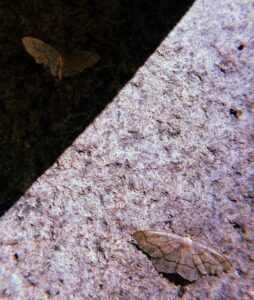
Deceased kin visiting as western hemlock looper moths? Photo by erica hiroko isomura.
~
The archaeologist believed forced displacement during the war years was the reason behind this uncovering. Government agents from the BC Security Commission slashed through Japanese Canadian communities after we were deemed enemy aliens in 1941.
“When people leave, usually they take all the good stuff with them. It all supports my hypothesis that people continued to live here until internment because it’s really apparent to me, they just walked away from their little houses with a lot of good stuff in them.”[viii]
~
For diasporic artists, there is an ever-present difficulty to building a home without access to language, culture, food, or the land of one’s ancestors.
Someone once told me that Vancouver was a spiritual home for Japanese Canadians and I believed her, moving to the city within the years to follow as I connected with more and more of my people, getting involved with community. It seemed as if I had found a lot of “good stuff” in this city, too.
But what does it mean to create a spiritual home on somebody else’s homelands?
~
“I appreciate that there’s a lot that I don’t have to explain to you in terms of what I am writing about. You accept the content for what it is and if you have questions because this doesn’t make sense or it isn’t consistent, it is about craft.” I tell Hiromi, after she inquires about my decision to continue learning by way of independent mentorship rather than a graduate studies university program. “There is so much gatekeeping in the arts. Barriers often exist for BIPOC, queer and trans people to access resources, education, or supports where they can have their craft taken seriously.”
“You don’t have to worry about the burden of teaching me colonial history or understanding something through an anti-racist lens.” Hiromi nods. “You don’t have to do that teaching for us to be able to talk about the craft.”
~
“One of the last artefacts we found was actually the key to the house,” said the archaeologist.[ix]
~
“Does writing—published writing—become a kind of site where we can find temporary homes for ourselves in the cultural imaginary (landscape)?” Hiromi later asks me.
Unlike some of my friends, who are also artists, I do not require a concrete floor for a printing press or additional space for a stand-up bass, an upright piano, or a sewing machine. When it comes to basics, writers require a sheet of paper and a pen. The rest is left up to one’s own imagination and hard work—writers must sit and return to the blank page over and over again. Like snails, writers carry our small homes with us, patting the key in our pockets wherever we go.
“There’s definitely something about being a writer that I think of as good, honest labor—there is a doggedness to it. You have to believe in it. It’s kind of an act of faith.” Hiromi further explains, “I don’t necessarily mean a spiritual faith, but it could be. You need to believe in the project and in yourself to be able to get through it because it’s a marathon, especially if you’re working on something like a novel or a creative nonfiction book-length manuscript. It’s a long road and hardly any of it is glamorous except for the rah rah party at the end, and then it’s over. Then you start all over again.”
~
Between dappled light and the shaded woodland floor, I share ideas for my nascent book project with Hiromi. The two of us sit in the valley basin and inhale deeply, listening to water rush behind swaths of sword ferns, salmonberry, huckleberry, and black cottonwoods. We sit together as mentor and mentee, book author and book author-to-be, both learners and teachers in our own ways.
Today, the forest is alive and breathing and so are we. Some far off day, we may return to this place again, perhaps as moths. After all, we too are future ancestors.
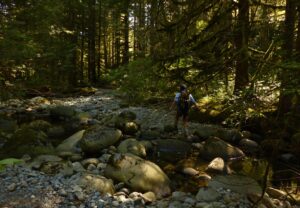
erica hiroko isomura crosses a dry stream bed in Ch’ich eliwxih. Photo by Hiromi Goto
~
Author’s note: Excerpts from “A Conversation on Queer Mentorship” at Queer Arts Festival have been edited and condensed for clarity.
[i] Queer Arts Festival, “A Conversation on Queer Mentorship,” Vimeo, Video, July 25, 2020. https://vimeo.com/441641765#t=36m45s
[ii] Brigit Katz. “Hidden Japanese Settlement Found in Forests of British Columbia,” Smithsonian Magazine. September 3, 2019. https://www.smithsonianmag.com/smart-news/hidden-japanese-settlement-found-forests-british-columbia-180973028/
[iii] North Shore News, “Japanese logging camp on the Seymour River,” YouTube, Video, August 15, 2019. https://www.youtube.com/watch?v=PtMGyg-T2AY
[iv] Heather Anne Longworth. “Tracks, Tunnels and Trestles: An Environmental History of the Construction of the Canadian Pacific Railway” (2009): 31. Accessed October 27, 2020. https://www.bestlibrary.org/files/ma-thesis—dspacecopy.pdf
[v] Coastal First Nations Great Bear Initiative and Sierra Club BC. (2015). Going Wild! Teaching about Wild Products from BC’s Coastal Rainforests: A Guidebook for Educatiors for Grades 4 -7. https://sierraclub.bc.ca/wp-content/uploads/Going-Wild-Guidebook.pdf
[vi] Nancy J. Turner and Fikret Berkes. “Coming to Understanding: Developing Conservation through Incremental Learning in the Pacific Northwest.” Human Ecology 34, no. 4 (2006): 495-513. http://www.jstor.org/stable/27654136
[vii] Brent Richter. “Nikkei secrets unearthed on the Seymour.” North Shore News, August 16, 2019. https://www.nsnews.com/news/nikkei-secrets-unearthed-on-the-seymour-1.23917368
[viii] Ibid.
[ix] Ibid.
